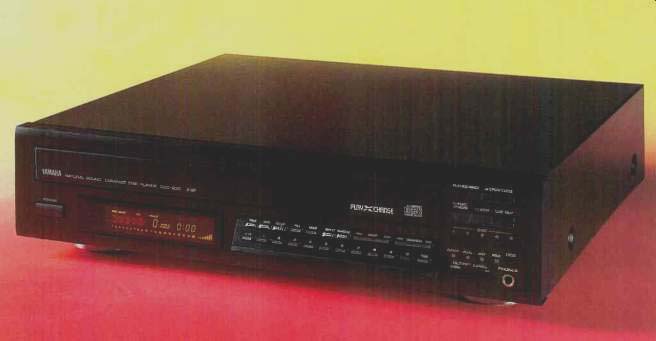
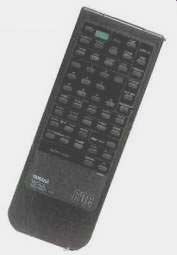
Manufacturer's Specifications:
Frequency Response: 2 Hz to 20 kHz, ±0.3 dB.
THD + N: 0.0018% at 1 kHz.
S/N: 115 dB.
Dynamic Range: 100 dB.
Output Level: Line, 2.0 V; headphone, 200 mV.
Output Impedance: Line, 730 ohms; headphone, 150 ohms.
Power Requirements: 120 V a.c., 60 Hz 20 watts.
Dimensions: 17 1/8 in. W x 4 1/4 in. H x 15 1/4 in. D (43.5 cm x 10.8 cm x 38.7 cm).
Weight: 14 lbs., 5 oz. (6.5 kg).
Price: $549
Company Address: 6660 Orangethorpe Ave., Buena Park, Cal. 90620.
A pair of five-disc CD changers recently introduced by Yamaha, the CDC-735 and CDC-835, incorporate a number of worthwhile and uncommon touches. The Model CDC-835, re viewed here, is the more expensive and feature-laden of the pair.
An unusual convenience is Yamaha's PlayXchange, which isolates the disc being played from the changer drawer. This eliminates vibration and permits up to four of the discs in the carousel tray to be removed and re placed while the fifth disc plays.
The D/A converter is Yamaha's S-Bit Plus, a single-bit system that uses Independent-Pulse Density Modulation (I-PDM) to generate separate, more accurate pulses for each channel. According to Yamaha's engineers, this converter improves low-level linearity, low-level signal purity, and high-frequency response clarity. The analog sections following the D/A operate in Class A, according to Yamaha.
The CDC-835 uses memory extensively. The player can store the table of contents (TOC) for all five discs at once instead of reading each disc's TOC as the disc is accessed; this speeds track selection, especially for programs that span several discs. A tape editing feature also functions with all five discs, so that a "favorite hits" tape can be easily assembled to fit the two sides of a cassette. A Program File memory can store program selections and order for up to 100 discs with up to 10 programmed selections from each.
The same memory can store your chosen settings for the built-in digital equalizer. This equalizer, another un usual feature of the CDC-835, provides five settings ("Rock," "Vocal," "Jazz," "Classic," and "Flat"). Memorized set tings for any disc will be activated whenever that disc is played.
Another unusual feature, Relay Play, permits two Yamaha changers to be connected together for uninterrupted 10-disc play. Other features include remotely controllable digital level control for headphone and line outputs, two-mode random play, four-mode re peat play, direct track access, five-disc direct access, music search and skip search, four-mode time display, three-mode display illumination, and a front-panel headphone jack. The CDC 835 is supplied with a 47-key remote control and is compatible with other Yamaha RS system components.
Control Layout
Only the most often used controls are normally visible on the front panel:
"Power," "PlayXchange," "Open/ Close," "Play/Pause," "Stop," "Disc Skip," five buttons for selecting discs or selecting and activating digital equalizer settings, the "Output Level" rocker, and the headphone jack. Less often used controls are accessed by opening a hide-away control panel that contains the required numeric buttons as well as other buttons used in programming. "Random" play, "Search," track "Skip," and "Repeat" buttons, as well as "Time" mode and display-illumination mode buttons, are also found on this subpanel.
The rear panel of the CDC-835 is equipped with a coaxial digital output jack, gold-plated analog line output jacks, and jacks and connectors used with Relay Play to allow two Yamaha players to work together. The remote control duplicates just about all of the front panel's controls. It also has an "Index" access button which enables you to start play from a given index point within a track (if index points are encoded on the disc) and permits you to move to any other desired index point. This is not done the usual way, which is by pressing the "Index" but ton each time you want to move to a higher index number. (In fact, pressing that button a second time will take you out of index mode.) Instead, you key in the index point you want by using the numeric buttons on the subpanel or the remote.
Measurements
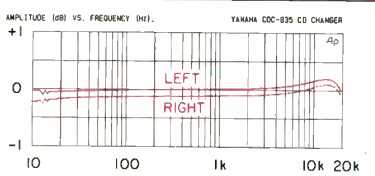
Fig. 1-Frequency response.

Fig. 2-THD + N vs. frequency as percent of maximum level.

Fig. 3-THD + N vs. signal level.
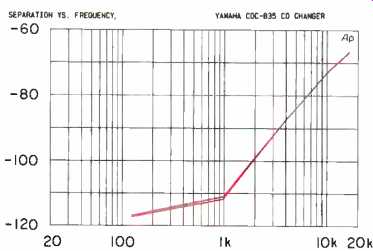
Fig. 4-Separation vs. frequency.
Figure 1 shows the frequency response of the CDC-835. The published specification of ±0.3 dB to 20 kHz is easily met, but there is a difference in output levels between left and right channels. This difference amounts to approximately 0.15 dB.
Figure 2 is a plot of THD + N versus frequency for signals at maximum re corded level. My left-channel reading of 0.002% at 1 kHz (slightly lower in the right channel) does not quite meet the rated 0.0018%, but the difference is hardly worth worrying about. I was impressed by the fact that THD + N does not rise significantly at the higher treble frequencies, as is the case with many CD players I have tested.
Figure 3 shows how THD + N varied with signal amplitude. Here, the right channel exhibits a slightly lower level of THD + N than does the left channel, but even the left-channel reading is some 96.5 dB below maximum recorded level over most of the range of amplitudes measured. This corresponds to a distortion percentage of 0.0015%.
At maximum recorded level, the reading is about -95.0 dB, or 0.0018%, yielding close correlation with the result obtained in Fig. 2. The fact that this level of THD + N is maintained even at 0-dB recorded level indicates that the analog output stages are not reaching overload levels and are properly de signed to handle the amplitudes involved.
To see how much of the THD + N figure was THD alone, I ran a spectrum analysis (not shown). It revealed mainly second and fourth harmonics, at around -100 and -108 dB, respectively. The spectral information allowed me to calculate a pure THD figure of 0.00108%. Additional spectrum analysis allowed me to compare quantization distortion for low-level dithered and undithered signals. For the dithered signal, only random noise was visible, but overall residual noise level was somewhat higher (peaking at -120 dB compared with peaks of -125 dB for the undithered signals).
This is the worthwhile trade-off that dithering provides for low-level signal reproduction.
Although channel separation exceeds 110 dB at 1 kHz (Fig. 4), it decreases substantially at higher frequencies, measuring only about 66.5 dB at 16 kHz. From a practical point of view, this level of high-frequency separation is more than adequate, but I wonder why such a decrease occurred. Perhaps it was due to component and wiring layout, with the culprit being capacitive coupling between channels in the final analog stages or output cables.
Overall A-weighted S/N for the CDC 835 measured 114.74 dB for the left channel and 114.85 dB for the right channel. An unweighted spectrum analysis (not shown) of residual noise revealed very minor power-line hum peaks that reached no higher than a totally inaudible -119 dB at 120 Hz.
Mostly, though, the noise was below about-130 dB up to 2 kHz, rising gently to about-115 dB at 20 kHz.
Low-level linearity of this changer is as good as any I have measured for even the costliest single-disc players.
Yamaha's one-bit system of D/A conversion results in a deviation of less than 0.64 dB at -90 dB for undithered signals, as shown in Fig. 5. The same holds true for low-level linearity using dithered signals, also shown in Fig. 5.
Here I noted even less deviation, all the way down to -100 dB. Both channels exhibit essentially the same mini mal deviation from perfect linearity in these tests.

Fig. 5-Deviation from perfect linearity.
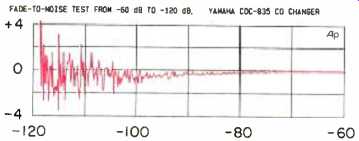
Fig. 6-Fade-to-noise test.
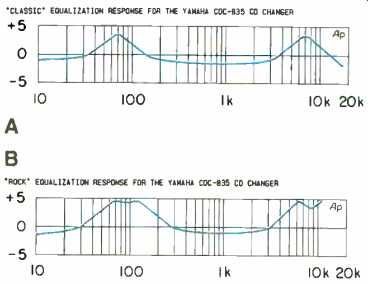
Fig. 7-Digital equalizer response in "Classic" setting (A) and "Rock" setting
(B).
Further evidence of better than usual low-level linearity can be seen in the fade-to-noise test (Fig. 6), in which a signal gradually decreases in amplitude from -60 to -120 dB until it fades into the residual noise. Dithered signals were used, and once again, the deviation from perfect linearity is minimal. This test also serves to define EIA dynamic range, which, for this Yamaha changer, was approximately 110 dB. Using the somewhat different EIAJ method of calculating dynamic range, I came up with a figure of 99.0 dB for the left channel and- 100.2 dB for the right.
A remarkable aspect of the CDC 835 was its internal clock accuracy, which was as close to perfect as I could measure within the limits of my test equipment. Deviation from perfect timing accuracy was a negligible 0.003%.
Use and Listening Tests
The CDC-835 was extremely resistant to external vibration. With a disc playing, I pounded on both the top and the sides of the changer's cabinet, and at no time did I detect any evidence of mistracking or muting. On the other hand, using my Pierre Verany "defects" disc, I found that the changer was able to correct for missing data extending to 0.77 mm but that mis tracking occurred when the length of missing data increased to 1.0 mm. Al though this degree of error correction exceeds the minimum required by the CD standard, it is not up to the error-correction capabilities of some CD players I have tested.
With the CDC-835's digital equalizer at its "Flat" setting, I felt that the sound was somewhat deficient in brightness and mid-bass. However, when I switched to the "Classic" equalization mode, which adds mild boosts in both those areas (Fig. 7A), the balance seemed to improve. I noticed this on a recent release of Rachmaninoff's Sym phony No. 2 (Telarc CD-80312) and a modern work, Paul Creston's Symphony No. 3 ( Delos DE 3114). When listening to pop and rock, I found the music more dynamic and more emotionally exciting when I used the digital equalizer's "Rock" setting (Fig. 7B). As I might have expected, the "Vocal" set ting (not shown) introduced a mid range boost that tended to bring the singer's voice forward.
The CDC-835's convenience features are outstanding, and anyone who likes the idea of owning a multiple-disc CD player with extensive programmability would do well to consider this unit. I would rank its measured performance equal to the better single-play units selling for a comparable or even higher price.
-Leonard Feldman
(Audio magazine, Dec. 1992)
Yamaha CDX-11101U CD Player (Sept. 1988)
Yamaha CDX-2020 Compact Disc Player (Dec. 1989)
= = = =